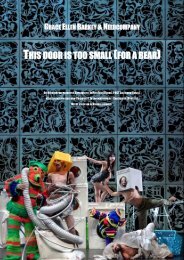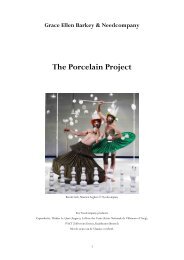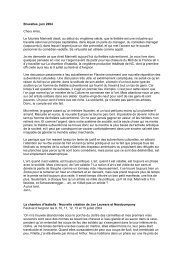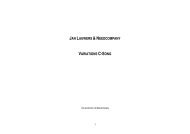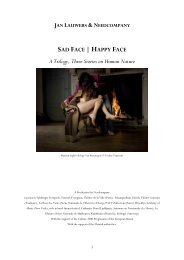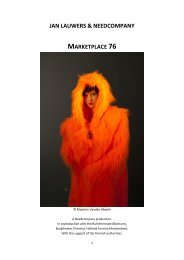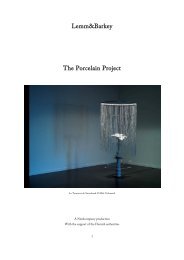THE ART OF ENTERTAINMENT - Needcompany
THE ART OF ENTERTAINMENT - Needcompany
THE ART OF ENTERTAINMENT - Needcompany
You also want an ePaper? Increase the reach of your titles
YUMPU automatically turns print PDFs into web optimized ePapers that Google loves.
JAN LAUWERS (long version)<br />
Jan Lauwers (Antwerp, 1957) is an artist who works in just about every medium. Over the last twenty years<br />
he has become best known for his pioneering work for the stage with <strong>Needcompany</strong>, which was founded in<br />
Brussels in 1986. <strong>Needcompany</strong> has been artist-in-residence at the Burgtheater in Vienna since 2009. Over<br />
the years he has also built up a substantial body of art work which was shown in an exhibition at BOZAR<br />
(Brussels) in 2007. Jan Lauwers is awarded with the ‘Decoration of Honour in Gold for Services to<br />
the Republic Austria’ (2012).<br />
Jan Lauwers studied painting at the Academy of Art in Ghent. At the end of 1979 he gathered round him a<br />
number of people to form the Epigonenensemble. In 1981 this group was transformed into the<br />
Epigonentheater zlv collective which took the theatre-world by surprise with its six stage productions. In<br />
this way Jan Lauwers took his place in the movement for radical change in Flanders in the early ‘80, and<br />
also made his international breakthrough. Epigonentheater zlv presented direct, concrete, highly visual<br />
theatre that used music and language as structuring elements. Their productions were Already Hurt and not<br />
yet War (1981), dE demonstratie (1983), Bulletbird (1983), Background of a Story (1984) and Incident<br />
(1985). Jan Lauwers disbanded this collective in 1985 and founded <strong>Needcompany</strong>.<br />
NEEDCOMPANY<br />
Jan Lauwers needs company. He founded <strong>Needcompany</strong> together with Grace Ellen Barkey. They together<br />
are responsible for <strong>Needcompany</strong> larger-scale productions. The group of performers Jan Lauwers and Grace<br />
Ellen Barkey have put together over the years is quite unique in its versatility. Their associated performing<br />
artists are MaisonDahlBonnema (Hans Petter Dahl & Anna Sophia Bonnema), Lemm&Barkey (Lot Lemm &<br />
Grace Ellen Barkey), OHNO COOPERATION (Maarten Seghers & Jan Lauwers) and the NC ensemble, which<br />
includes the inimitable Viviane De Muynck. They create work of their own under <strong>Needcompany</strong>’s wing.<br />
Since <strong>Needcompany</strong> was founded in 1986, both its work and its performers have been markedly<br />
international. Its first productions, Need to Know (1987) and ça va (1989) – which received the Mobiel<br />
Pegasus Preis – were still highly visual, but in subsequent productions the storyline and the main theme<br />
gained in importance, although the fragmentary composition remained.<br />
Lauwers’ training as an artist is decisive in his handling of the theatre medium and leads to a highly<br />
individual and in many ways pioneering theatrical idiom that examines the theatre and its meaning. One of<br />
its most important characteristics is a transparent, ‘thinking’ acting and the paradox between ‘acting’ and<br />
‘performing’.<br />
This specific approach is also to be found in his adaptations of Shakespeare: Julius Caesar (1990), Antonius<br />
und Kleopatra (1992), <strong>Needcompany</strong>’s Macbeth (1996), <strong>Needcompany</strong>’s King Lear (2000) and, at the<br />
Deutsches Schauspielhaus in Hamburg, Ein Sturm (2001). After directing Invictos (1996), the monologue<br />
SCHADE/Schade (1992) and the opera Orfeo (1993), in 1994 he started work on a major project called The<br />
Snakesong Trilogy, which signalled his first full emergence as an author: Snakesong/Le Voyeur (1994),<br />
Snakesong/Le Pouvoir (1995) and Snakesong/Le Désir (1996). In 1998 he staged the reworked version of the<br />
whole Snakesong Trilogy.<br />
In September 1997 he was invited to take part in the theatre section of Documenta X (Kassel), for which he<br />
created Caligula, after Camus, the first part of a diptych called No beauty for me there, where human life is<br />
21




